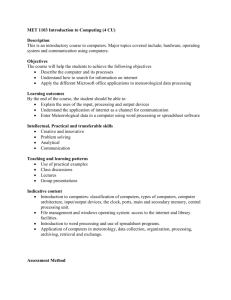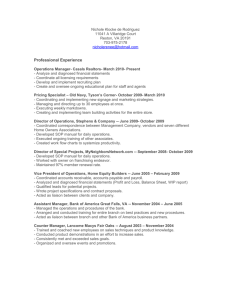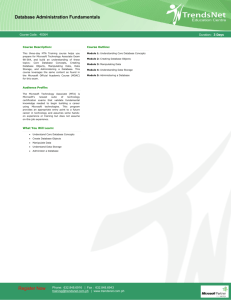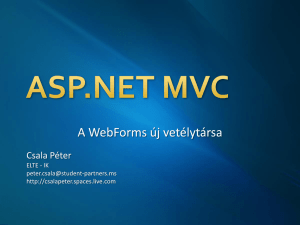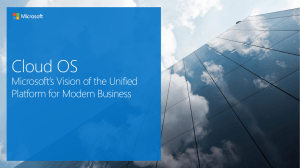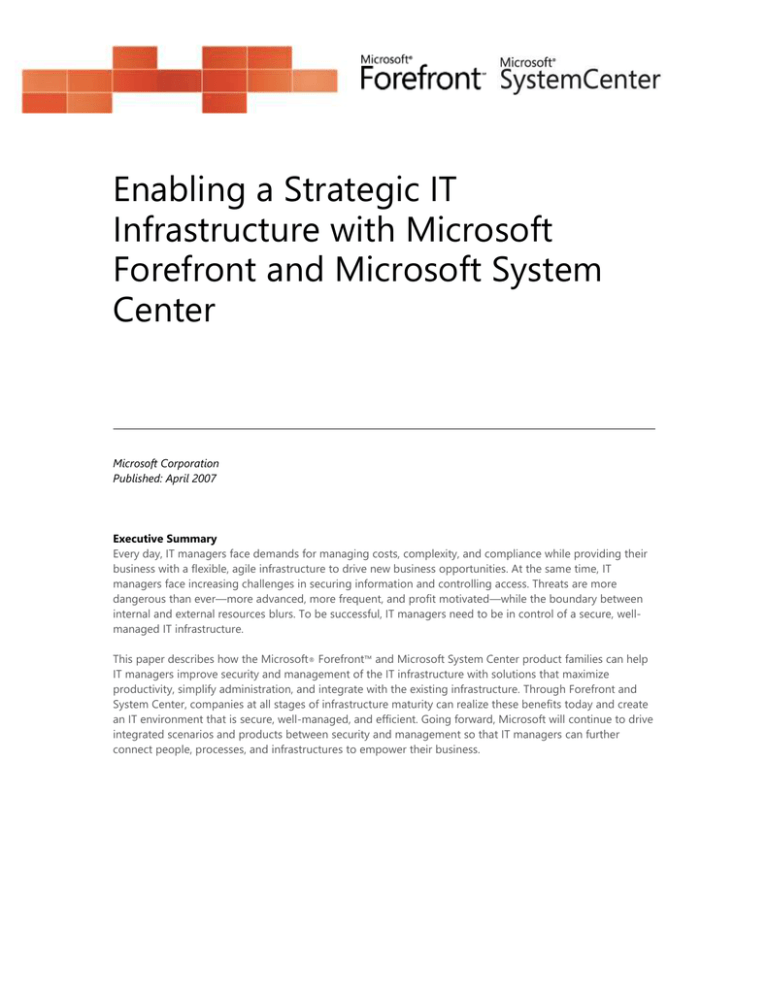
Enabling a Strategic IT
Infrastructure with Microsoft
Forefront and Microsoft System
Center
Microsoft Corporation
Published: April 2007
Executive Summary
Every day, IT managers face demands for managing costs, complexity, and compliance while providing their
business with a flexible, agile infrastructure to drive new business opportunities. At the same time, IT
managers face increasing challenges in securing information and controlling access. Threats are more
dangerous than ever—more advanced, more frequent, and profit motivated—while the boundary between
internal and external resources blurs. To be successful, IT managers need to be in control of a secure, wellmanaged IT infrastructure.
This paper describes how the Microsoft® Forefront™ and Microsoft System Center product families can help
IT managers improve security and management of the IT infrastructure with solutions that maximize
productivity, simplify administration, and integrate with the existing infrastructure. Through Forefront and
System Center, companies at all stages of infrastructure maturity can realize these benefits today and create
an IT environment that is secure, well-managed, and efficient. Going forward, Microsoft will continue to drive
integrated scenarios and products between security and management so that IT managers can further
connect people, processes, and infrastructures to empower their business.
ENABLING A STRATEGIC INFRASTRUCTURE WITH MICROSOFT FOREFRONT AND MICROSOFT SYSTEM CENTER
Contents
Introduction ....................................................................................................................................................................................................3
The “Uncontrollable” IT Environment ............................................................................................................................................3
Regaining Control ..................................................................................................................................................................................3
Enabling a Strategic IT Infrastructure ...................................................................................................................................................4
Microsoft Forefront ...............................................................................................................................................................................4
Microsoft Forefront Client Security ..........................................................................................................................................4
Microsoft Forefront Server Security .........................................................................................................................................5
Microsoft Forefront Edge Security and Access ....................................................................................................................5
Microsoft System Center ...........................................................................................................................................................................5
Delivering a Productive, Simplified, and Integrated Environment ...........................................................................................7
Productive .................................................................................................................................................................................................7
Automate Routine Tasks ...............................................................................................................................................................7
Use Microsoft’s Embedded Knowledge .................................................................................................................................8
Maintain End-User Productivity .................................................................................................................................................8
Simplified ...................................................................................................................................................................................................9
Easily Secure and Manage Infrastructure...............................................................................................................................9
Understand State of Security and System Health ..............................................................................................................9
Gain Rapid Insight into Critical Events ................................................................................................................................. 10
Integrated ............................................................................................................................................................................................... 11
Build on Windows Platform and Applications .................................................................................................................. 11
Extend Security and Management Capabilities................................................................................................................ 11
Get the Most Value Out of the Infrastructure ................................................................................................................... 12
Moving Forward ......................................................................................................................................................................................... 12
Conclusion .................................................................................................................................................................................................... 13
For More Information ........................................................................................................................................................................ 14
ENABLING A STRATEGIC INFRASTRUCTURE WITH MICROSOFT FOREFRONT AND MICROSOFT SYSTEM CENTER
Introduction
Secure and well-managed: These two terms describe an ideal IT infrastructure—one that supports growth
and fuels business opportunities. Yet in a fast-paced, ever-changing business environment, many
organizations find their IT infrastructure difficult to manage and remain vulnerable to security threats. Such
an IT infrastructure can drain resources, and even become a liability.
The “Uncontrollable” IT Environment
The complexity of the IT environment in many organizations is at an all-time high—a result of a growing list
of business applications and systems that have been added to address business challenges, enable new
business scenarios, and foster growth. IT managers must maintain the health of this increasingly intricate IT
environment.
At the same time, while the rise of the Internet has delivered unsurpassed advantages—such as enabling
remote work scenarios—it has also opened the door to a steady stream of more advanced, more frequent
security threats. As workforces become more dispersed, and the boundary between internal and external
resources blurs, IT managers must find the balance between managing network security and fostering the
highest level of employee productivity. Often, achieving the right balance requires integrating multiple
systems and technologies—a solution that can further complicate the IT environment and may even expose
the enterprise to additional security threats.
Adding to the challenge, IT managers must maintain constant vigilance and utmost control. Only then can
they proactively manage systems and identify and address security issues before they become critical. How
can businesses address these challenges and turn a possible IT liability into a business asset?
Regaining Control
To help the business meet its objectives, IT managers need tools and technologies that help secure and
manage the IT environment in a cost effective and efficient manner. The market offers many choices, yet few
deliver an all-encompassing solution. As a result, businesses implement multiple point solution products—
each of which requires its own management console. With multiple management consoles, IT managers are
challenged to get a clear view into the systems and security state of their environment. What’s more, these
tools may be difficult to deploy, use, or manage; they may not integrate easily into the existing environment;
or they may consume excessive resource time—detracting from tasks that deliver true business value.
At Microsoft, we never lose sight of the people who deploy, configure, and use our software to secure and
manage their environment. We are committed to delivering on the promise of infrastructure software that
enables IT managers to manage complexity and achieve agility while protecting information and controlling
access. Today, we offer a combined solution that hands back the reigns of control to IT managers:
Microsoft® Forefront™ and Microsoft System Center. These portfolios work together as a cohesive solution
to deliver the benefits of a productive, simplified, and integrated platform.
Microsoft Forefront and Microsoft System Center
3
ENABLING A STRATEGIC INFRASTRUCTURE WITH MICROSOFT FOREFRONT AND MICROSOFT SYSTEM CENTER
Enabling a Strategic IT Infrastructure
The IT infrastructure should be an organization’s greatest strategic asset and business enabler. Unlocking
that potential requires alignment between IT and the business, a mature infrastructure, and a balance
between people, processes, and technology. To help companies advance from costly and inefficient IT
environments, Microsoft offers guidance in the form of the Core Infrastructure Optimization (IO) Model. This
model outlines steps companies can take to analyze where they are today and to plan for and create an IT
environment that is secure, well-managed, and efficient. In the most mature state, IT is incorporated into
business strategy and used as a valuable asset in the growth and success of the company.
Businesses that advance in maturity through this model can achieve tangible benefits. For example, IDC
found that organizations that moved from basic to rationalized infrastructure in the Core IO model could, on
average, reduce their IT labor costs for desktop infrastructure by more than 80 percent: from $1,320 per PC
per year to $230 per PC per year.1
Security and management are integral parts of the core infrastructure of every business. Together with other
Microsoft technologies in the Core IO Model, Forefront™ and System Center solutions can help IT managers
achieve these benefits and more.
Microsoft Forefront
The Microsoft® Forefront family of business security products helps IT managers protect information and
control access to their environment. Microsoft Forefront solutions integrate with an organization’s IT
infrastructure and can be supplemented with interoperable third-party solutions, enabling end-to-end, indepth security solutions. Simplified management, reporting, analysis, and deployment enable more efficient
protection of information resources, as well as more secure access to applications and servers. With highly
responsive protection that is supported by Microsoft technical guidance, Microsoft Forefront helps IT
managers confidently meet ever-changing threats and increased business demands.
Microsoft Forefront helps protect client and server operating systems and application servers from viruses,
spyware, Trojans, spam, and other threats. Forefront products also provide network edge protection to
provide safer remote work scenarios and access control. The following sections provide greater detail about
how Forefront solutions help
protect client and server
operating systems, application
servers, and the network edge.
Microsoft Forefront Client
Security
Microsoft Forefront Client
Security provides unified
malware protection for
business desktops, laptops,
and server operating systems
that is easy to manage and
control. Built on Microsoft
Figure 1. Forefront protects the network edge, server applications, and client
protection technology that is
and server operating systems.
already used by millions of
people worldwide, Forefront Client Security helps guard against viruses, spyware, worms, Trojan horses, and
other current and emerging threats. In addition, Forefront Client Security delivers simplified administration
and provides critical visibility into both threats and vulnerabilities so that security administrators can
maintain control over their security state. Forefront Client Security also integrates with an organization’s
existing infrastructure software, such as Active Directory® directory services, and complements other
1
IDC, Optimizing Infrastructure: The Relationship Between IT Labor Costs and Best Practices for Systems Management Server, January 2007.
Microsoft Forefront and Microsoft System Center
4
ENABLING A STRATEGIC INFRASTRUCTURE WITH MICROSOFT FOREFRONT AND MICROSOFT SYSTEM CENTER
Case Study: Vienna
International Airport
Major European Airport
Maintains Operational Efficiency
with Upgraded Security Solution
Business Situation
The Vienna International Airport
hadn’t experienced a virus
attack in years. As it migrated to
Microsoft® Exchange Server
2007, it wanted to keep things
that way.
Solution
The airport also migrated to
Microsoft Forefront™ for
Exchange Server, the successor
to the Microsoft Antigen
product it had already used
successfully.
Benefits
Higher level of virus detection
More potent anti-spam
defense
Easy to deploy, configure, and
maintain
Able to better secure more of
the environment
“Forefront Security for Exchange
Server can be part of a much
broader security and
management infrastructure.
That’s important as we look for
new ways to increase our
operational efficiency.”
Astrid Christ
Project Manager, IT-Solutions
Vienna International Airport
Microsoft security technologies for advanced protection and control.
Microsoft Forefront Server Security
Microsoft Forefront Server Security includes the following solutions that
integrate multiple scan engines from industry-leading vendors to help
organizations protect business-critical Microsoft messaging and
collaboration servers from viruses, worms, spam, and inappropriate
content before they can impact businesses and users:
Microsoft Forefront Security for Exchange Server includes
multiple scan engines from industry-leading security firms, integrated into
a single solution to help businesses protect their Microsoft Exchange
messaging environments from viruses, worms, and spam. Through deep
integration with Exchange Server, scanning innovations, and performance
controls, Forefront Security for Exchange Server helps protect messaging
environments while maintaining uptime and optimizing server
performance. Forefront Security for Exchange Server also enables
administrators to easily manage configurations and operations, to
automate scan engine signature updates, and to generate reports at the
server and enterprise level.
Microsoft Forefront Security for SharePoint® help businesses
protect their Microsoft SharePoint collaboration environments by
eliminating documents containing malicious code, confidential
information, and inappropriate content. Microsoft Forefront Security for
SharePoint manages and integrates multiple industry-leading antivirus
engines to provide comprehensive protection against the latest threats,
helping to ensure documents are safe before they are saved to or
retrieved from the SharePoint document library. Through deep integration
with Microsoft Office SharePoint Server 2007 and Windows SharePoint
Services 3.0, Forefront Security for SharePoint helps protect an
organization’s collaboration environment while maintaining uptime and
optimizing performance.
Microsoft Forefront Edge Security and Access
The following Forefront edge security and access products provide
enhanced network edge protection and application-centric, policy-based
access to the corporate IT infrastructure.
Microsoft Internet Security and Acceleration Server (ISA) 2006 is
an integrated edge security gateway that helps protect IT environments
from Internet-based threats while providing users fast and secure remote
access to applications and data. ISA Server helps IT managers to securely
publish content for remote access, connect and secure branch offices, and
defend against external and internal Web-based threats.
Intelligent Application Gateway (IAG) 2007 provides secure
socket layer (SSL) virtual private network (VPN), a Web application firewall,
and endpoint security management that enable access control,
authorization, and content inspection for a wide variety of line-of-business
applications. This solution provides mobile and remote workers with easy,
flexible, and secure access from a broad range of devices and locations,
while enabling IT administrators to enforce compliance with application
and information usage guidelines.
Microsoft System Center
Microsoft Forefront and Microsoft System Center
5
ENABLING A STRATEGIC INFRASTRUCTURE WITH MICROSOFT FOREFRONT AND MICROSOFT SYSTEM CENTER
System Center is Microsoft’s family of IT management solutions that helps IT managers proactively plan,
deploy, manage, and optimize their physical and virtual IT environment. It plays a central role in Microsoft’s
vision to help IT organizations benefit from self-managing, dynamic systems. System Center solutions
capture and aggregate knowledge about an infrastructure, policies, processes, and best practices so that IT
staff can optimize the IT structure to reduce costs, improve application availability, and enhance service
delivery.
With an aim to enable self-managing dynamic systems, System Center solutions provide comprehensive
management of physical and virtual environments, resulting in improved efficiencies and better control.
Some of the world’s most successful companies use System Center solutions to help manage the most
mission-critical IT systems, applications, and services and to achieve the reliability, scalability, and security
they need.
Enterprise IT departments need solutions that support performance and availability monitoring; software
updates and deployment; data storage and recovery; problem management; capacity management; IT
reporting; and operations management. The System Center family encompasses the following leading IT
management solutions that accommodate all of these needs:
Microsoft System Center Operations Manager 2007 (formerly known as Microsoft Operations
Manager [MOM]) provides best-of-breed, end-to-end service management for the Windows®
operating system, helping IT organizations increase efficiency and gain greater control over the IT
environment.
Microsoft System Center Configuration Manager 2007 (formerly known as Microsoft System
Management Server [SMS]), enables more secure and scalable operating systems and application
deployment, desired configuration management, system quarantine, and comprehensive asset
management of servers, desktops, and mobile devices.
Microsoft System Center Capacity Planner 2006 is a pre-deployment, capacity-planning solution
that provides best-practice guidance and hardware-specific knowledge for IT professionals planning a
deployment for Exchange Server or Operations Manager.
Microsoft System Center Virtual Machine Manager 2007 is a stand-alone management application
for a virtualized data center that enables administrators to increase physical server utilization and
centrally manage virtual infrastructure, and enables both administrators and users to rapidly provision
new virtual machines.
Figure 2. The Microsoft System Center ecosystem.
Microsoft Forefront and Microsoft System Center
6
ENABLING A STRATEGIC INFRASTRUCTURE WITH MICROSOFT FOREFRONT AND MICROSOFT SYSTEM CENTER
Microsoft System Center Essentials 2007 provides a unified management solution to help IT
professionals in midsize organizations proactively and efficiently manage their IT environment.
Microsoft System Center Service Manager provides IT staff a set of easy-to-use, highly automated
solutions for managing their infrastructure and services. Service Manager provides powerful
functionality in areas of incident, problem, asset and change management that, when integrated with
existing System Center products, provides a productive platform for end-to-end automation of IT
processes.
Microsoft System Center Data Protection Manager 2006 speeds disk-based backup and recovery,
delivers consistent data protection, and increases an IT organization’s operational efficiencies.
Delivering a Productive, Simplified, and Integrated Environment
System Center and Forefront solutions are uniquely positioned to help organizations create a secure, wellmanaged IT environment. This is enabled through the use of a common management infrastructure and
platform.
Forefront security solutions build on the deployment, reporting, and remediation capabilities of System
Center management solutions, enabling IT managers to save time and effort by securing and managing their
environment through a common infrastructure. In addition, Forefront and System Center are designed to
integrate with the Windows® platform and its applications. Both product families are optimized for Active
Directory and other Windows technologies to readily enable policy configuration and enforcement. They
also integrate with Microsoft applications such as Exchange Server and SharePoint Server, as well as
Windows server components to maximize their effectiveness. Forefront and System Center solutions further
benefit from Microsoft’s breadth of security and operational knowledge, technical guidance, and best
practices that are gained by supporting millions of customers worldwide on Microsoft applications and
infrastructure.
Together, Forefront and System Center help IT managers maximize productivity, provide simplified
administration, and integrate with an organization’s existing infrastructure. As a result, IT managers can
reduce costs, provide their business with a flexible infrastructure, and maintain control. Through Forefront
and System Center, companies at all stages of infrastructure maturity can realize these benefits today and
create an IT environment that is secure, well-managed, and efficient.
Productive
Forefront and System Center solutions enhance productivity by automating redundant tasks and enabling IT
managers to use Microsoft’s knowledge that is embedded into systems and security solutions.
Consequently, IT managers can spend less time administering systems and more time completing tasks that
maintain end-user productivity.
Automate Routine Tasks
By automating routine and redundant tasks, Forefront and System Center solutions help IT managers reduce
the time spent administering systems and focus on tasks that deliver real business value to the organization.
For example, System Center solutions use Active Directory and the Windows platform to automatically
discover information about systems. Through System Center solutions, IT managers can automatically and
remotely deploy agents that discover, connect, and self-activate management servers. IT managers can also
automatically identify, catalog, and report on software assets throughout the organization.
Similarly, Forefront solutions automate repetitive tasks required for maintaining the security of clients,
application servers, and the network edge. Forefront Client Security and Forefront Server Security products
automate signature updates for protecting clients and application servers, respectively, from threats. In using
a multi-engine approach, Forefront Server Security automatically monitors all scan-engine vendor Web sites
for updates, downloads, and signatures as they become available, which eliminates the need for IT
Microsoft Forefront and Microsoft System Center
7
ENABLING A STRATEGIC INFRASTRUCTURE WITH MICROSOFT FOREFRONT AND MICROSOFT SYSTEM CENTER
Case Study: HSBC
HSBC Improves Reliability, Security,
and Cost Savings for Desktop
Standardization Effort
Business Situation
HSBC needed desktop
management and server
monitoring solutions that were
scalable enough to support a
globally distributed environment
with 300,000 desktops and 15,000
server computers.
Solution
HSBC met its needs with
Microsoft® System Center
solutions, including Systems
Management Server 2003 for
desktop management and
Operations Manager 2005 for
monitoring critical Windows®based servers.
Benefits
Strong reliability and security
Improved service for internal
customers
Expected 20 percent reduction
in desktop cost of ownership
Strong integration of desktop
and server
“Not only does Systems
Management Server reduce the
effort required to help keep user
desktops secure, but it also reduces
security risk because we can push
out security updates much faster
than before.”
Matthew O’Neill
Group Head of Distributed
Systems
HSBC Global IT Operations
involvement. Internet Security and Acceleration Server also provides
automated tools that make it easy to more securely publish multiple
Web sites.
Use Microsoft’s Embedded Knowledge
With Forefront and System Center, IT managers can create a highly
optimized IT environment by using Microsoft’s deployment, operational,
and security knowledge. For example, management packs in System
Center Operations Manager deliver prescriptive guidance and
knowledge to help improve monitoring, troubleshooting, and problem
resolution for more than 50 Microsoft applications and operating
systems. With System Center Configuration Manager, administrators can
access configuration baselines for core Windows client and server
products to consistently create and maintain the desired configuration
state for clients and servers.
Forefront solutions benefit from Microsoft’s ongoing research into the
threat landscape. Microsoft’s intelligent global malware research system
consists of ongoing security research that is powered through volumes
of data collected and submitted by the community. Data on the threat
landscape comes from a breadth of internal and external sources,
including Forefront Server Security products, Windows Live™ OneCare™,
MSN®, Hotmail®, Exchange Hosted Services, other Microsoft protection
technologies, and community submissions. Microsoft’s experienced
virus and spyware research team combines this data with automated
analysis techniques to respond quickly to current and emerging threats
that impact customers.
Maintain End-User Productivity
Forefront and System Center provide solutions that help IT managers to
proactively manage systems, protect data, and control access so that
end-user interruptions can be avoided.
In monitoring systems health, System Center Operations Manager
proactively monitors system utilization and Windows client reliability
and incorporates troubleshooting knowledge to help IT managers
quickly identify and resolve end-user problems. System Center
Configuration Manager provides IT managers with model-based
management techniques to help them ensure that systems comply with
corporate policies and maintain good system health, uptime, and
performance.
While System Center solutions help maintain system health and
compliance with corporate policies, Forefront solutions help IT
managers protect end-users from interruptions due to malware. For
example, Forefront Client Security’s integrated anti-virus and antispyware engine provides real-time protection from viruses, spyware,
and other threats for the operating system of desktops, laptops, and
servers. Forefront Server Security products use multiple scan engines to
protect end-users of applications such as Exchange Server and
SharePoint Server while maintaining uptime and optimizing server
performance.
Microsoft Forefront and Microsoft System Center
8
ENABLING A STRATEGIC INFRASTRUCTURE WITH MICROSOFT FOREFRONT AND MICROSOFT SYSTEM CENTER
Productive: A Customer Example
Forefront and System Center, together with other Microsoft technologies, can help cut downtime on key IT
services by more than 20 percent.2
SOK Group, one of Russia’s largest manufacturers, previously relied on a third-party product to protect its
central e-mail infrastructure. However, the single scan engine in that product sometimes allowed new viruses
to slip through. As the company upgraded to Microsoft® Exchange Server 2007, it decided to also migrate to
Microsoft Forefront Security for Exchange Server.
As a result, SOK Group expects to cut the downtime of its e-mail infrastructure by 20 to 30 percent. This
improvement will come primarily from the ability to use five scan engines simultaneously in Forefront
Security for Exchange Server, compared to the single scan engine in its previous security product.
“With the multiple simultaneous scan engines in Forefront Security for Exchange Server, we did not have a
single virus infection.”
Petr Grachev
Chief Information Officer
SOK Group
Simplified
Through Forefront and System Center solutions, IT managers can simplify the deployment, configuration,
management, and security of their environment. With centralized management consoles that use familiar
Microsoft interfaces, IT managers can get clear visibility into systems health and security trends and easily
drill-down into key details. By providing rapid insight through prioritized information, Forefront and System
Center solutions enable IT managers to take action when and where it’s needed to help maintain a secure,
well-managed infrastructure.
Easily Secure and Manage Infrastructure
Forefront and System Center give IT managers the tools and technology they need to easily deploy,
configure, manage, and secure their IT infrastructure to meet business needs and reduce costs.
System Center solutions are designed to simplify the management of Microsoft-based systems and
applications while enabling IT managers to complete a diverse assortment of tasks. Using System Center
solutions, an IT manager can use native management capabilities—that range from Windows Mobile®
devices to enterprise-class Windows-based servers—to administer the smallest hardware component, the
most complex, service-oriented architecture based IT services, and anything in between.
With Forefront solutions, administrators and users alike benefit from simplified, centralized distribution of
up-to-date configuration, policies, and updates for clients and servers. The management consoles for
Forefront products are easy to use, reduce training time, and help control business costs. Because Forefront
solutions are also simple to deploy and configure throughout the organization, they help avoid
misconfigurations that can lead to security issues.
Understand State of Security and System Health
Forefront and System Center solutions provide IT managers with clear visibility into the state of security and
systems health and emerging trends, enabling quick drill-down into key details. In addition to reporting on
viruses, spyware, and other threats, Forefront Client Security enables IT managers to conduct state
assessment scans, so that they can determine which managed computers need patches or are configured
2
Results are not typical and are based on use with Forefront Security for Exchange Server, Microsoft Exchange Server 2007, and other
technologies. Availability is dependent on many factors, including hardware and software technologies, mission-critical operational
processes, and professional services.
Microsoft Forefront and Microsoft System Center
9
ENABLING A STRATEGIC INFRASTRUCTURE WITH MICROSOFT FOREFRONT AND MICROSOFT SYSTEM CENTER
insecurely. The reporting functionality included enables administrators to measure their security risk profile
based on security best practices. While Forefront Client Security reports on threats and vulnerabilities,
System Center Operations Manager can be used to get visibility into the systems health of those clients.
System Center Operations Manager provides an easy-to-use environment that tracks thousands of event and
performance monitors across hundreds of operating systems and applications. Complementing both
solutions, System Center Configuration Manager makes it easy to discover and fix system vulnerabilities; to
identify systems that lack compliance with corporate policies; and to ensure that the latest hardware and
software security updates are applied.
Gain Rapid Insight into Critical Events
Forefront and System Center solutions help IT managers focus their attention on key events through
prioritized information, so that they can take action when and where it’s needed. Security alerts in Forefront
Client Security notify administrators when threats appear in the environment, eliminating the need to search
through volumes of data. At the network edge, the strong logging and reporting capabilities within Internet
Security and Acceleration Server enhance monitoring of clients that are accessing corporate resources so
that attacks can be better identified.
System Center Operations Manager enables aggregate reporting of client systems so support teams can
focus on resolving high impact products and scale to manage tens of thousands of client systems. System
Center Configuration Manager helps identify common system configuration problems and allows IT
managers to create their own customer scans to avoid inhibitors to Service Level Agreements.
Simplified: A Customer Example
Forefront and System Center, together with other Microsoft technologies, can help reduce administrative
overhead by more than 40 percent3.
Tyco Healthcare, a global leader in medical devices, supplies, and pharmaceuticals, wanted in-depth
information about infrastructure performance to boost effectiveness, reduce costs, and support growth—
information it wasn’t getting from its monitoring software. As a result, the company adopted Microsoft ®
Systems Center Operations Manager 2007 software. In addition to getting more information than it received
from its previous monitoring solution, the company estimates that it will save 45 percent of the cost of
managing its environment by moving to Operations Manager 2007, in part because it can monitor more
remote hubs and sites without requiring additional servers.
“[Microsoft Systems Center Operations Manager] opened our eyes to service-level monitoring . . . Its bottomline impact is that we understand what we have out there and what it’s doing.”
Joseph Davis
Project Manager
Tyco Healthcare
3
Results are not typical and are based on use of System Center Operations Manager 2007 and other technologies. Availability is dependent
on many factors, including hardware and software technologies, mission-critical operational processes, and professional services.
Microsoft Forefront and Microsoft System Center
10
ENABLING A STRATEGIC INFRASTRUCTURE WITH MICROSOFT FOREFRONT AND MICROSOFT SYSTEM CENTER
Case Study: Independent
Budget Office (IBO) of New
York
New York Budget Analysis Agency
Enhances Remote Connectivity
While Reducing Costs
Business Situation
The IBO wanted to provide its
executives with an easy-to-access
VPN solution that would integrate
with the Active Directory®
directory service and Microsoft®
Exchange Server 2003 to provide
secure access, scalability, and
reduced administration.
Solution
Based on recommendations by
Cartwright & Goodwin, a
Microsoft Certified Partner, the
IBO installed a Network Engines
NS6300 Security Appliance—
which is powered by Microsoft®
Internet Security and Acceleration
Server—on the network edge.
Benefits
60 percent reduction in security
administration time
Enhanced productivity
50 percent reduction in
acquisition costs
Increased security
“[The NS6300] reduces network
bandwidth requirements, and
enables staff members to be more
efficient and productive across the
board.”
Stephen R. Goodwin
Chief Executive Officer
Cartwright & Goodwin
Integrated
Forefront and System Center solutions integrate with the Windows
platform, its applications, and management infrastructure, enhancing
the overall effectiveness and responsiveness of existing systems so that
IT managers can get the most value out of their investments.
Build on Windows Platform and Applications
Forefront and System Center increase the value of an organization’s
investment in Microsoft technology, because each solution builds and
expands on the capabilities of the Windows platform, applications, and
infrastructure. For example, Forefront Client Security is optimized for
Active Directory® Group Policy for configuring security agents on
clients. Forefront Security for Exchange Server uses the intelligent
antivirus transport stamp in Exchange Server 2007 to prevent multiple
scanning of messages and to conserve valuable messaging server
resources. At the network edge, Microsoft’s Intelligent Application
Gateway includes customized, granular access policy and security
capabilities that provide secure remote access to Exchange Server,
SharePoint Server, and other applications.
In managing IT environments, System Center solutions integrate with
Microsoft-based systems and applications such as the Windows
operating system, Windows Server operating system, Exchange Server,
Microsoft SQL Server™, Microsoft Office, and others. System Center
solutions also use most of the technology that was developed through
the Dynamic Systems Initiative, which is Microsoft’s effort to enable
knowledge about an IT system to be created, modified, and operated on
throughout the IT system’s life. Knowledge, guidance, and best practices
for managing workloads and Windows-based systems come directly
from Microsoft development teams and are built into solutions from the
System Center family.
Extend Security and Management Capabilities
Forefront and System Center also interoperate with third-party
products, enabling IT administrators to take advantage of existing
applications. For example, System Center Operations Manager can
monitor third-party applications that are already a part of the
infrastructure. System Center partners also provide custom service
templates and management applications to extend System Center’s
capabilities to monitor and control third-party infrastructure and
applications such as SAP, Oracle, Apache, Linux, and other server
operating systems.
Within the Forefront security product family, Internet Security and
Acceleration Server provides an application-layer inspection platform
that integrates third-party URL filtering, XML filtering, and Session
Initiation Protocol filtering products to provide unified threat
management. Intelligent Application Gateway integrates with a range of
third-party client-side products—including anti-virus, firewall, and other
security-related technologies—to support end-point security and policy
enforcement capabilities during remote access.
Microsoft Forefront and Microsoft System Center
11
ENABLING A STRATEGIC INFRASTRUCTURE WITH MICROSOFT FOREFRONT AND MICROSOFT SYSTEM CENTER
Get the Most Value Out of the Infrastructure
Forefront and System Center help IT managers maximize the value of their existing investments by building
on a common management infrastructure and supporting industry standards and best practices. Both
product families are optimized for Active Directory and other Windows technologies to readily enable policy
configuration and enforcement. Forefront security solutions build on the deployment, reporting, and
remediation capabilities of System Center management solutions. As a result, IT managers can use the same
infrastructure to both secure and manage their environment, saving time and effort.
System Center solutions support industry standards such as the IT Infrastructure Library (ITIL) and the
Microsoft Operations Framework (MOF) to provide best practices that facilitate the delivery of high-quality IT
services. MOF is a collection of best practices, principles, and models based on the ITIL. MOF is prescriptive,
providing operational guidance that enables organizations to achieve mission-critical system reliability,
availability, and manageability of Microsoft products and technology.
Integrated: A Customer Example
Forefront and System Center, together with other Microsoft technologies, can help organizations save more
than 60 percent on IT costs4.
For example, Carnival Cruise Lines wanted to boost the availability of a Microsoft® Exchange Server
deployment that was crucial to ship-to-shore communications, as well as boost availability on its increasingly
important e-commerce Web site. As a result, it deployed Microsoft Systems Center Operations Manager
2007. In addition to expecting to increase Exchange Server availability from 90-to-95 percent to 99 percent
and availability on the e-commerce Web site to near-24 x 7 uptime, it has also been able to reduce costs and
boost IT efficiency in other ways.
Operations Manager 2007 enabled the company to consolidate what had been three configuration groups
into just one [a reduction of 67%]. The three configuration groups had been necessary to give three sets of
administrators their own views into the monitoring environment. Now, role-based security groups in
Operations Manager 2007 accomplish those same role-specific views in a single installation. Database
administrators now only see alerts related to database operation, rather than having to pore through alerts
from the entire infrastructure.
“..Now, when administrators see alerts, they know those alerts are relevant to them and they can take
immediate action. The enterprise operates more efficiently—and our administrators do, too.”
Rodney Orange
Supervisor, Wintel Server Engineering Team
Moving Forward: Integrated Scenarios & Products
Today, Forefront and System Center deliver a comprehensive set of security and management solutions that
share a common management infrastructure and platform. As a result, IT managers can maximize their
productivity while maintaining end-user productivity, simplify the task of administration, and integrate
security and management with their existing infrastructure. Through Forefront and System Center,
companies at all stages of infrastructure maturity can realize these benefits today and create an IT
environment that is secure, well-managed, and efficient. Companies can also discover how the breadth of
Microsoft’s infrastructure offerings can help them achieve their objectives.
4 Results are not typical and are based on use of System Center Operations Manager 2007 and other technologies. Availability is dependent
on many factors, including hardware and software technologies, mission-critical operational processes, and professional services.
Microsoft Forefront and Microsoft System Center
12
ENABLING A STRATEGIC INFRASTRUCTURE WITH MICROSOFT FOREFRONT AND MICROSOFT SYSTEM CENTER
Case Study: Nissan
IT Management Solutions Help
Nissan Reduce Costs, Improve
Reliability and Productivity
Business Situation
Nissan’s IT infrastructure was hard
to manage and support, leading
the company to embark on a
rigorous effort of simplification
and standardization.
Solution
Nissan is centralizing and
streamlining IT management with
Microsoft® System Center
solutions, including Systems
Management Server 2003 and
Operations Manager 2005.
Benefits
Enhanced end-user productivity
through increased reliability and
security
Improved IT staff productivity
through automated software
deployment and remote
support capability
Labor cost savings of 40,000
hours in six months
“We’re committed to delivering a
14 percent reduction in IT spending
through technology simplification,
and we expect a lot of that savings
to come from the work that we’re
doing with System Center
solutions.”
Celso Guiotoko
Corporate Vice President and
Global Chief Information Officer
Nissan
Forefront and System Center will provide a foundation for other
integrated scenarios and features that connect people, processes, and
infrastructure. For enterprises that are composed of large teams with
specialized roles in security and management, Microsoft will continue to
offer two product families: Forefront for security-based roles and
System Center for management-based roles. Going forward, these
product families can be unified through a common “service
management” solution that enables workflow definition, process
automation, and comprehensive reporting across security and
management. Through this, security specialists and management
specialists can standardize their processes for gathering and prioritizing
incidents; assigning resources to address issues; and managing changes
and resolving problems. By having a central hub through which IT
processes and activities are tracked, IT can provide business managers
with visibility into the overall performance of their environment through
centralized reporting.
On the other hand, mid-market and smaller customers are broadly
composed of IT Generalists who need a standard, integrated set of tools
that enable them to perform both IT security and IT management
functions. For these customers, Microsoft plans to deliver integrated
systems and security management solutions that enable them to save
time and do more with the same amount of resources through a rolesbased approach. As a result, IT managers can focus on the critical
aspects of their environment.
Regardless of an organization’s size, integrated security and
management scenarios and products will be enabled through the
common management infrastructure and shared platform that exists
today between Forefront and System Center solutions. Through
Forefront and System Center, IT managers can achieve self-managing,
dynamic systems optimized for securing and managing their IT
environment—for both the present and the future.
Conclusion
Over the past decade, the Internet and the proliferation of technology
have contributed to an increasingly complex IT environment that is
more at risk to security threats. As a result, IT managers are left
searching for tools and technology that enable a more secure, wellmanaged IT infrastructure. Unfortunately, many of these solutions are
complex, costly, and difficult to integrate, and ultimately detract from
creating a cost-effective and optimized IT infrastructure.
Today, Microsoft offers two solutions that give IT managers a
comprehensive set of technologies that support business agility. With
Forefront, IT managers can better protect information and control
access to the IT environment. With System Center, IT managers can
proactively plan, deploy, manage, and optimize the physical and virtual
IT environment. Together, Forefront and System Center provide a
powerful combination of technology that supports a highly integrated,
simplified, and productive IT environment.
Microsoft Forefront and Microsoft System Center
13
ENABLING A STRATEGIC INFRASTRUCTURE WITH MICROSOFT FOREFRONT AND MICROSOFT SYSTEM CENTER
As illustrated earlier, a number of customers have experienced the benefits that Forefront and System Center
solutions can deliver. Together with other Microsoft technologies, customers using Forefront and System
Center solutions have cut downtime by more than 20 percent, reduced administrator overhead by more than
40 percent, and saved more than 60 percent on IT costs5. In addition, Forefront and System Center, along
with other Microsoft solutions included in the Core Infrastructure Optimization Model, can help companies
move from a basic IT environment to a rationalized IT environment—a transformation that can help
companies reduce IT labor costs by more than 80 percent for desktop infrastructure6.
Microsoft is committed to delivering on the promise of infrastructure software that enables IT managers to
manage complexity and achieve agility while protecting information and controlling access. Through
Forefront and System Center solutions, IT managers can achieve the benefits of a secure and well-managed
infrastructure—reducing costs and empowering the business, while maintaining control.
For More Information
For the latest information about Forefront or System Center products, please see
www.microsoft.com/forefront and www.microsoft.com/systemcenter
© 2007 Microsoft Corporation. All rights reserved. The information contained in this document represents the
current view of Microsoft Corporation on the issues discussed as of the date of publication. Because Microsoft
must respond to changing market conditions, it should not be interpreted to be a commitment on the part of
Microsoft, and Microsoft cannot guarantee the accuracy of any information presented after the date of
publication. The information represents the product at the time this document was printed and should be used
for planning purposes only. Information subject to change at any time without prior notice. This data sheet is
for informational purposes only. MICROSOFT MAKES NO WARRANTIES, EXPRESS OR IMPLIED, IN THIS
SUMMARY.
5 Results are not typical and are based on use of Forefront, System Center and other technologies. Availability is dependent on many
factors, including hardware and software technologies, mission-critical operational processes, and professional services.
6 IDC, Optimizing Infrastructure: The Relationship Between IT Labor Costs and Best Practices for Systems Management Server, January 2007.
Microsoft Forefront and Microsoft System Center
14


